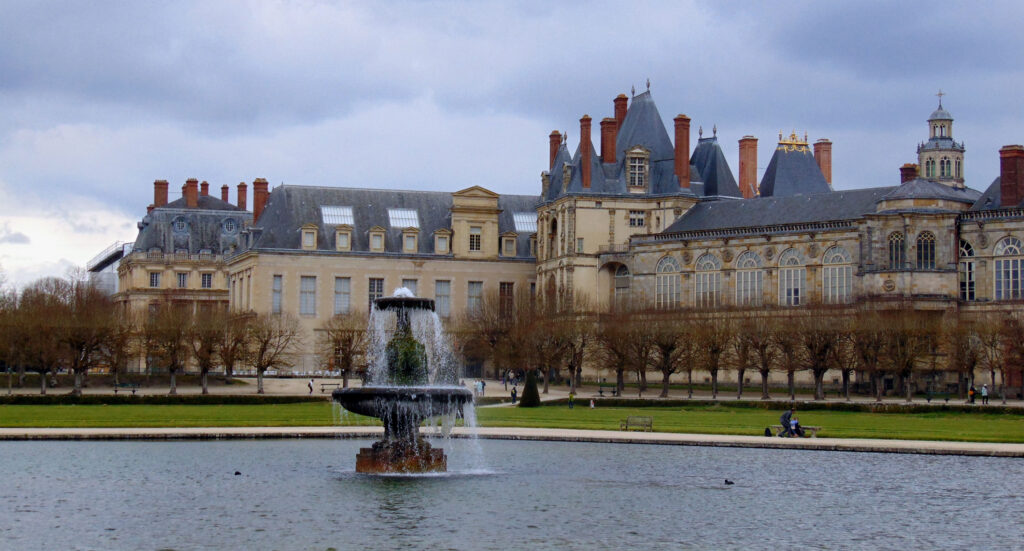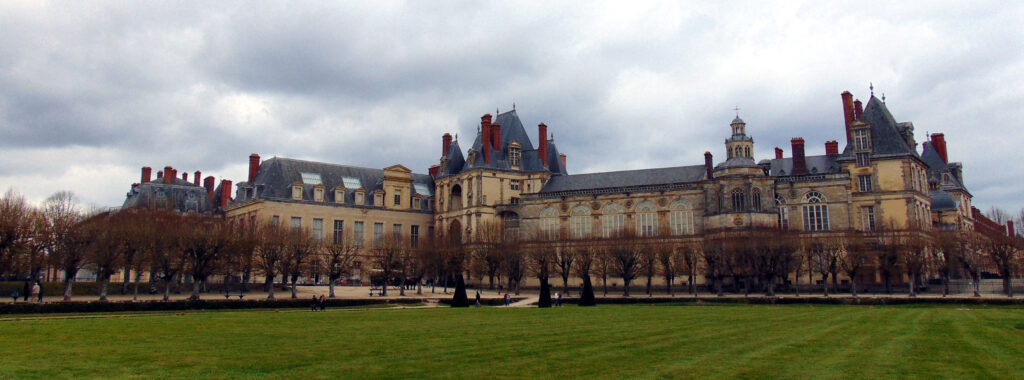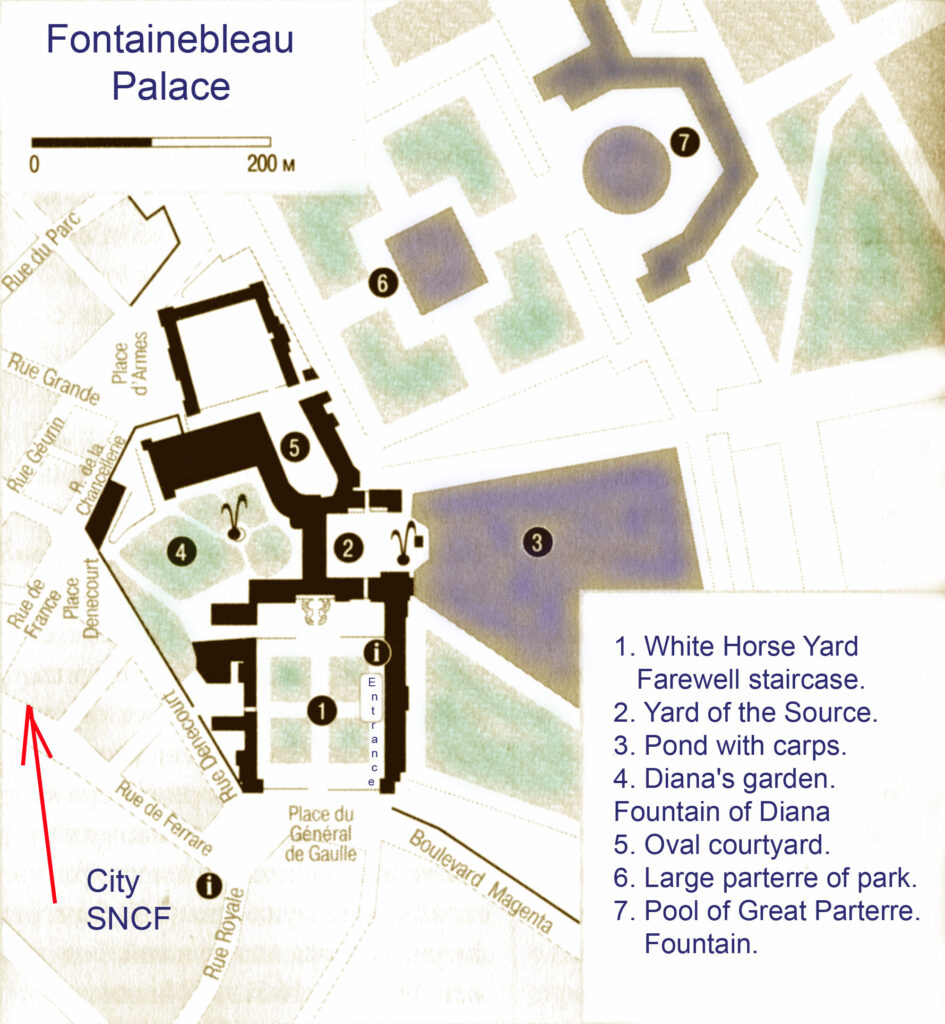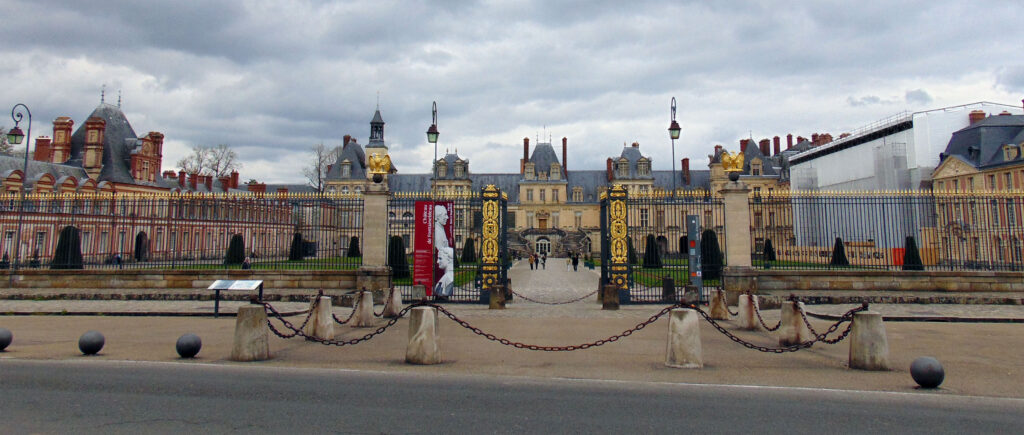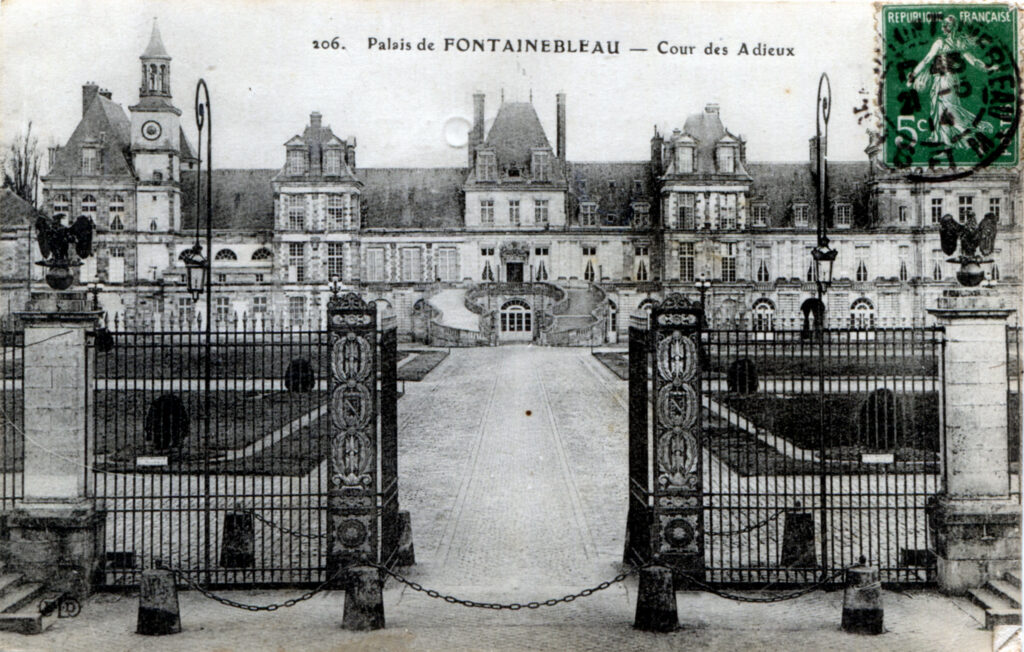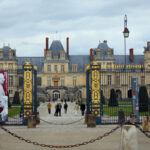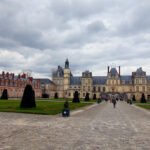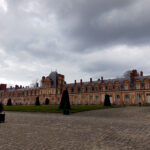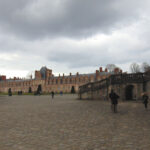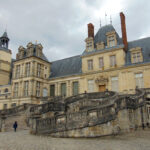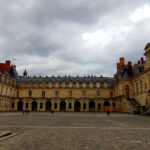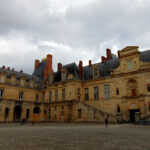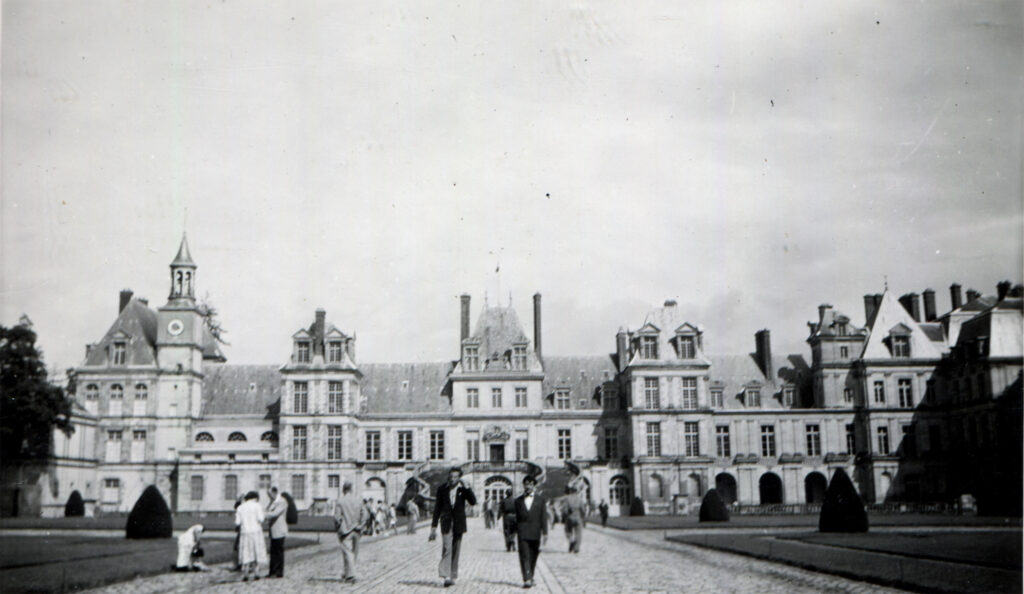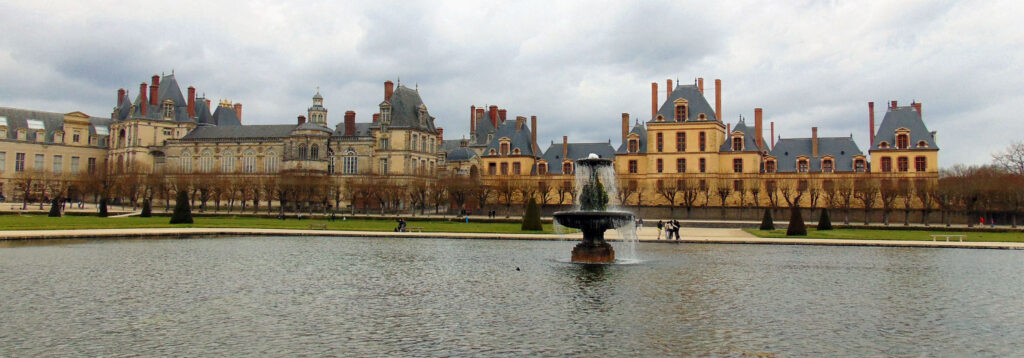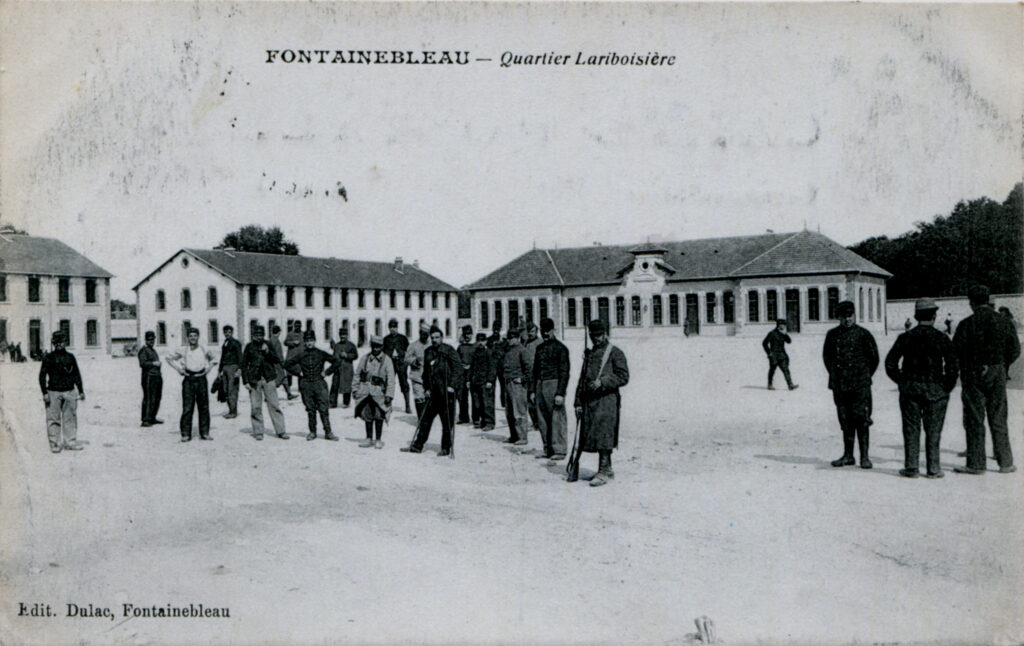Fontainebleau (French Fontainebleau – Blue Spring) is a French commune located in the Seine-et-Marne department in the Ile-de-France region, a beautiful place loved by tourists from all countries.
Photo: View of the pond, fountain and castle in Fontainebleau. Private tour from Paris in April (like on the autumn, in November, same). There are clouds, no rain. And not as hot as in summer. The fountains are working even in April.
Manor and castle of Fontainebleau.
Fontainebleau Castle Virtual tour.
Location on the map of the castle, the Palace of Fontainebleau, the ponds, the Napoleon 1 Museum, the parks and alleys, the fountains, the city itself and the railway station for Paris..
Palace. The entrance to the castle is located in the right wing of the Palace of the White Horse (wing of Louis XV). The name came about after Charles IX placed a copy of the equestrian statue of Marcus Aurelius from the Capitoline Hill in Rome. Although the statue itself has not been preserved, there is a gypsum tile in its place.
A horseshoe-shaped staircase leads to the central building of the courtyard. Built under Louis XIII by the architect Jean du Cerceau. The staircase is known for the fact that Napoleon said goodbye to his guard from it before leaving for the island of Elba.
Source Yard. It is located on the bank of the Pond with carps (the very ones that the Russian Cossacks fried and ate here in 1814). The spring itself contains pure water, which was used for the royal family. The Source Yard is bounded by the Beautiful Fireplace wing. The name comes from a fireplace located until the 18th century. This Court is separated from the Gardens of Diana by the gallery of Francis I.
Oval courtyard. It is the oldest in the palace ensemble, which was still at the first castle, from which only the tower (donjon) of Saint Louis remained. There is also the Golden Gate and an old clock from the period of Francis I on one of the buildings (decorated with a sculpture of 7 planets and the Roman god Vulcan, who beats every hour with a hammer).
The large parterre of the regular park, located to the east of the pond, was created by Le Nôtre and Levo. The canal (1200 meters) begins from the pool of the Great Parterre. In the center of the pool stands the sculptural group “An Eagle Fighting for Prey” (Keno, 1866).
Diana’s garden is located behind the left wing of the White Horse courtyard. The name comes from the statue of Diana erected by Henry IV. The bronze sculptural group (sculptor Biar) in the center of the fountain (engineer Franzini) includes a statue of Diana with a roe deer, four hunting dogs and four deer heads. In the park around the palace there is a source of Blo, which served as the name of the area. The flower garden was made during the time of Francis I, and in the 17th century it was redone by Le Nôtre. The forest of Fontainebleau has an area of 25,000 hectares and can be used for walking or cycling.
Castle, First floor:
– Small apartments (22 rooms), – salons
— Chinese Museum of Empress Eugenia
Second floor: – Large apartments, – renaissance halls
– Interior apartments of Napoleon I, — Museum of Napoleon I
Visitors on a marble staircase (stucco) enter the halls of the second floor. In the lobby of the historical gallery you can see a stained glass window and two vases from the period of the Second Empire. The ceiling is decorated with coats of arms, paintings on historical themes are hung on the walls. Next comes the gallery of plates, built by Louis-Philippe, by whose order 123 plates from the Sevres factory were inserted into the wooden finish, also painted on historical themes. Further, the excursion from this hall goes to the gallery of Francis I, which is a long and narrow room (64 x 6 meters). The walls are finished with walnut wood with gilded elements. On the carved panels there are heraldic symbols “F” and a salamander. Between the windows on the wall are Italian frescoes with allegorical reflections of the king on the themes of morality and religion. The coffered wooden ceiling is also made in the Italian style. This gallery represents the “First School of Fontainebleau”.
Through the guardroom, the salon of Louis XV and the apartments of Madame Maintenon (the morgan wife of Louis XIV from 1683), the tour passes through the Ballroom, completed by Henry II, son of Francis the First. The architect Delorme made the ceiling coffered in a typical Italian style. The walls below are paneled in oak, carved with the initials of Henry II and his symbol – the moon. The top of the walls is decorated with frescoes depicting mythological scenes based on sketches by Primaticcio.
From the Ballroom you can see the Saint-Saturnin chapel with painted vaults, and then the bedroom of Madame d’Etampes. Under Francis, his favorite lived here, and under Louis XV, the bedroom became a staircase. On the wall there is a fresco by Primaccio “Alexander and Roxana”. Returning to the guardroom, we find ourselves in the large apartments of kings and queens.
The first and second halls of Saint Louis above the fireplace is a marble bas-relief of Henry IV, a clock from the workshop of Boulle (1725). The decoration of the halls was led by Louis XV. The salon of Francis I contains a fireplace, an ebony cabinet, an alabaster bas-relief of the goddess Diana with a deer (B. Cellini). Here is the queen’s bedroom, converted for the second wife of Francis I Eleanor of Austria. The tour then continues to the Diana Gallery (80 x 7 meters) with a barrel vault, where the library (17,000 volumes) is located. Interesting exhibits are a large globe (1810) and a vase made of Sevres porcelain (1822-1832).
You can return back along the other side of the suite through the White Salon, the Great Salon of the Empress and the bedroom, the Queen’s boudoir, the Napoleon’s throne room and the Council Hall. This is followed by the interior apartments of Napoleon I – a suite of rooms behind the wall of the gallery of Francis I:
– emperor’s bedroom, – small bedroom (Jacob’s mechanical table)
— a private salon (“Salon of Abnegation”), where the furnishings are preserved, a clock with an owl in a case of Sèvres porcelain, a bath, – Salon Adjutants, reception
After passing these halls you will find yourself in the galleries of plates.
According to legend, this French name “Fontaine-Bleau” was eventually transformed from “Fontaine-Belle-Eau” (“Wonderful source”). According to another version, during the royal hunt, a dog named “Bleau” found a source, which was named so. In any case, it was the presence of clean drinking water here that prompted Louis VII to build a hunting lodge here, which was first mentioned as a castle in 1137. In 1169, the castle chapel was consecrated by Thomas Becket himself, the Archbishop of Kenterburg, who left England for France for political reasons. In 1191, on the eve of Christmas in Fontainebleau, Philip II Augustus celebrated the return from the III Crusade. Born in Fontainebleau: Philip the Handsome, Francis II, Henry III, Louis XIII.
Guided tour to Fontainebleau, description.
Such a tour to Fontainebleau will allow you to see one of the largest buildings of the French Renaissance, built by Francois I, and continued by Henry II, then by his widow Catherine de Medici. Located in the middle of a forest of seventeen thousand hectares, Fontainebleau Castle was one of the privileged residences of the rulers of France. Hunting enthusiasts made the residence a regular visitor, and all its visitors had a desire to improve it with new buildings and decor.
Postcard with the local attractions: the Palace of Fontainebleau, “farewell” courtyard and gate. Pay attention to the lattice with ornaments and columns with “Napoleonic” eagles.
- Gate and entrance, as in the old photo
- Yard, main alley, park and tourists
- Wing of the palace complex on the left
- Front porch, sthe taircase to the courtyard
- Porch and steps on the other side
- And another general view of the front of the palace
- The courtyard of the palace and the parade ground
- Yard corner, arches and windows
A little about the history. Most of the Palace of Fontainebleau was built by the architect Le Breton, Serlio and Delorme during the reign of Francis I. Gone were the medieval buildings, which were replaced by two groups of buildings connected by a gallery. The collection of the palace contains works by talented artists under the supervision of the Italian masters Rosso and Primaticcio, written at the direction of Francis I in the antique style. These works made up the “First School of Fontainebleau”, from the buildings of which the gallery of Francis I, the ballroom and the bedroom of the Duchess d’Etampes have been preserved. Under Henry II, the construction and interior decoration of the ballroom, which is still the decoration of the palace, was completed. Henry IV significantly expanded the palace and built new administrative buildings. He invited the best French and Flemish artists (Dubois, Dubreuil, Freminet) to decorate his office, the deer gallery, and founded the so-called “Second Fontainebleau School”. Under Louis XIV, XV, XVI, improvements and expansions of the ensemble continued, mostly in the interior of the apartments. The revolution did not greatly affect the state, the palace was not plundered. Only the furniture was damaged. Under Napoleon the First, who became the First Consul, the castle turned into his main residence instead of Versailles. It was here in April 1814, after the capture of Paris by the Russian Cossacks, that he abdicated the throne and said goodbye to the guards in the courtyard of the White Horse, which since then also bears the second name “Farewell Yard” (see photo).
Fontainebleau Castle is rich in architectural and decorative styles. But it was during the Renaissance that the castle experienced the most colorful transformations. François I (1494 – 1547) fell in love with these places because of the forest, where he could “unleash his black and red beasts.” He loved Fontainebleau so much that when he returned there, he said “that he was going to his place.” He began the restoration and reconstruction of the castle from 1528. Preserving the medieval donjon, he built on one side a gilded door, a ballroom and the chapel of Saint-Saturnand (on the Oval Court) and on the other side of the building he built a real court of the white Horse, on the site redeemed in Triniter; as well as a gallery that tells about the life of François I. His son Enri II (1519 – 1559) then Catherine de Medici (1519 – 1589), his wife continued the work they had begun and added other buildings in the courtyard of the Fountain. To decorate the new buildings, François I called on Italian artists; Rosso (1494 – 1540) and Bolone, Primatis (1504 – 1570); they have been called the “First School of Fontainebleau”.
In addition, Francois I united in Fontainebleau various collections of paintings by Leonardo da Vinci, Andrea del Sarto, Raphael, sculptures, tapestries, precious stones, various curious things (today these collections are preserved in the Louvre and the National Library), all this created an artistic center in the castle collected from all over Europe.
Fontainebleau Castle also served for the brilliant celebrations organized by François I with his successors, among whom was the poet Ronsard.
Old photo. Neighborhoods of Paris. Castle and Palace of Fontainebleau. Old amateur photo from the 40s or early 50s. Glossy photo paper “Ridax” size 11.9 x 7.7 cm, cut with a curly cutter. Collection of M. Blinov (flea markets in Paris). Description of the photo: Judging by the stamp of the photo studio “Liege Photo-JO F146”, the amateurish photo was taken by a tourist from the city of Liege. The shooting date is not specified, but in the photo you can see a couple of people in military uniform, which was massive in 1945-1949. Approximately at this time, apparently, the photo was taken. In the foreground are two young men in jackets, one with his shirt collar unbuttoned, the other with a bow tie. In the background is a group of ten people. Most likely, this is a group tour from Paris with a guide. Before or after the start of the tour.
Museum of Emperor Napoleon I (Musée Napoleon 1er)
The museum occupies the entire first and second floors of the Louis XIV wing of the Château de Fontainebleau. The exposition is dedicated to Emperor Napoleon Bonaparte and his family. Sculptural and painted portraits, weapons, awards, personal items and documents about his coronation ceremony, military campaigns and his personal life. Tour of the Napoleon Museum is held only in the morning. For a long time the exposition was under reconstruction.
Fontainebleau and Russian Cossacks.
The expulsion of Napoleon from Russia ended with the campaign of the Russian army in France in 1814. During the fighting and the storming of Paris by the allies, Napoleon’s headquarters was located in Fontainebleau. It was here that on March 23 (April 4), 1814, who learned about the fall of Paris and the betrayal of Marshal O.F.L.V. de Marmont, Napoleon, under the influence of his marshals at Fontainebleau, abdicated and soon went into exile on the island of Elba.
The Russian army entered Fontainebleau. The Cossacks surprised the French not only with their appearance, but also with various “exploits”. So, for three weeks, the Chernigov Cossack regiments camped in Fontainebleau on the banks of the royal pond, in which there were giant mirror collection carps swimming near the shore. The carps were hungry, because the servants of the castle, who were supposed to look after them, fled. With the help of huge nets pulled by Cossack horses, 17 carps were caught, fried and safely eaten … No one was punished for this.
On May 18 (30), 1814, the French government of King Louis XVIII signed the Treaty of Paris with the victorious powers allied in the 6th coalition. Immediately after that, the Russian army left the territory of France.
Interesting Facts.
In 1717 Tsar Peter the Great visited Fontainebleau Palace.
Military history and battlefield tours
Barracks have been preserved on the outskirts of the palace, where the “guards” have been located for many centuries. Usually tourists do not go to this part of the outskirts of the territory. These military barracks are even depicted on old postcards from the beginning of the 20th century with views of the city. You can spend an extra 5-7 minutes and admire these interesting structures of military architecture.

